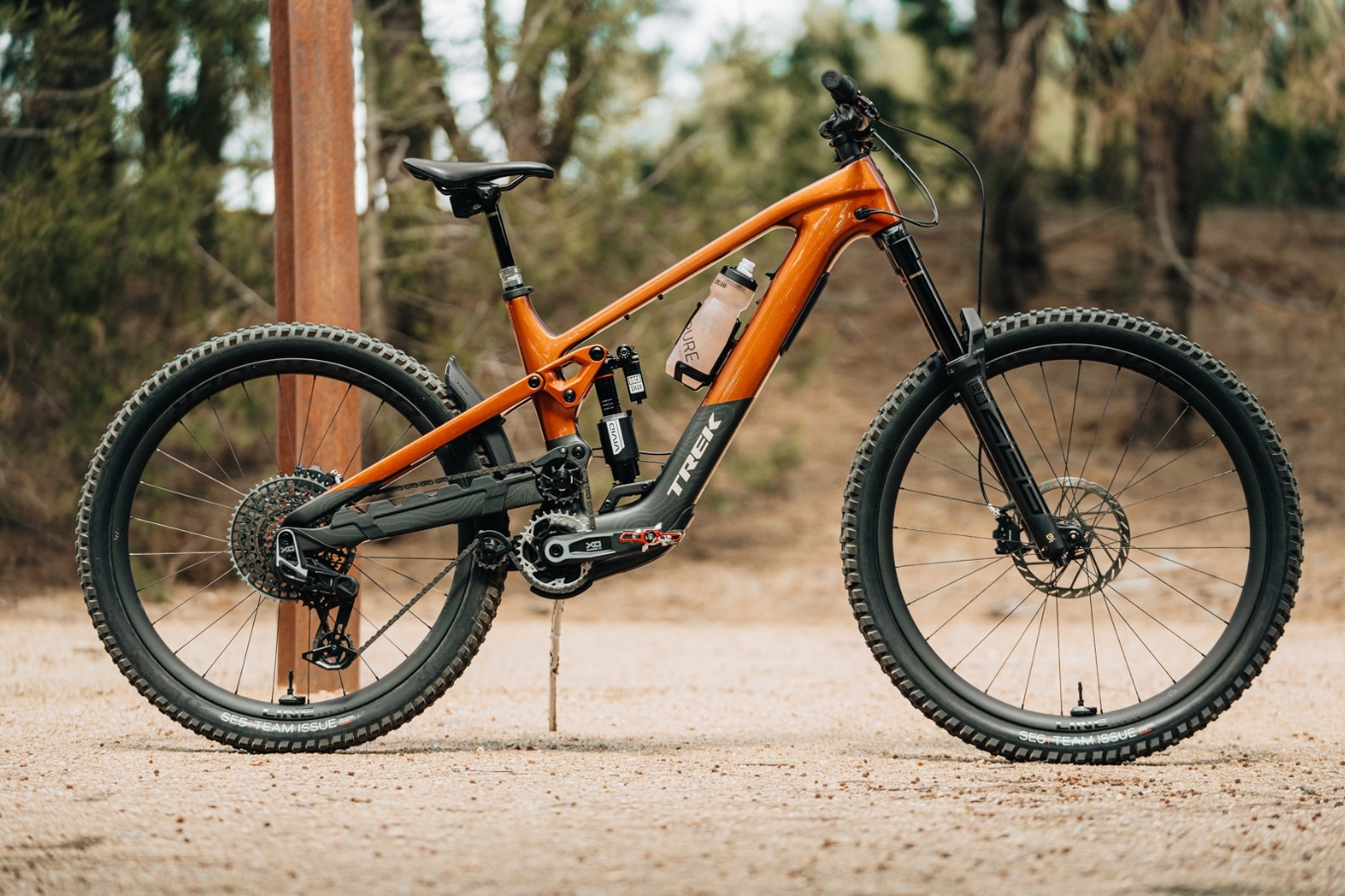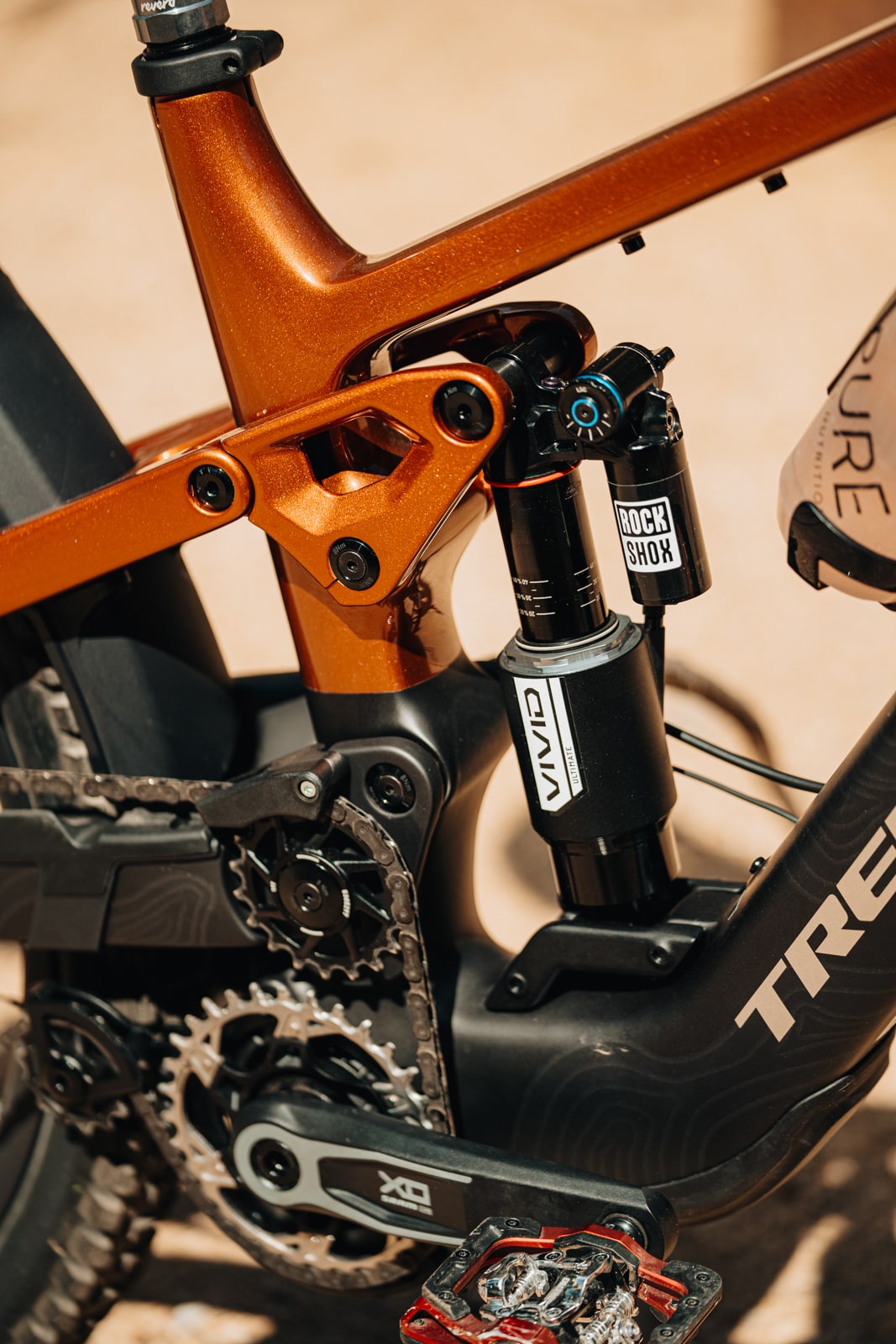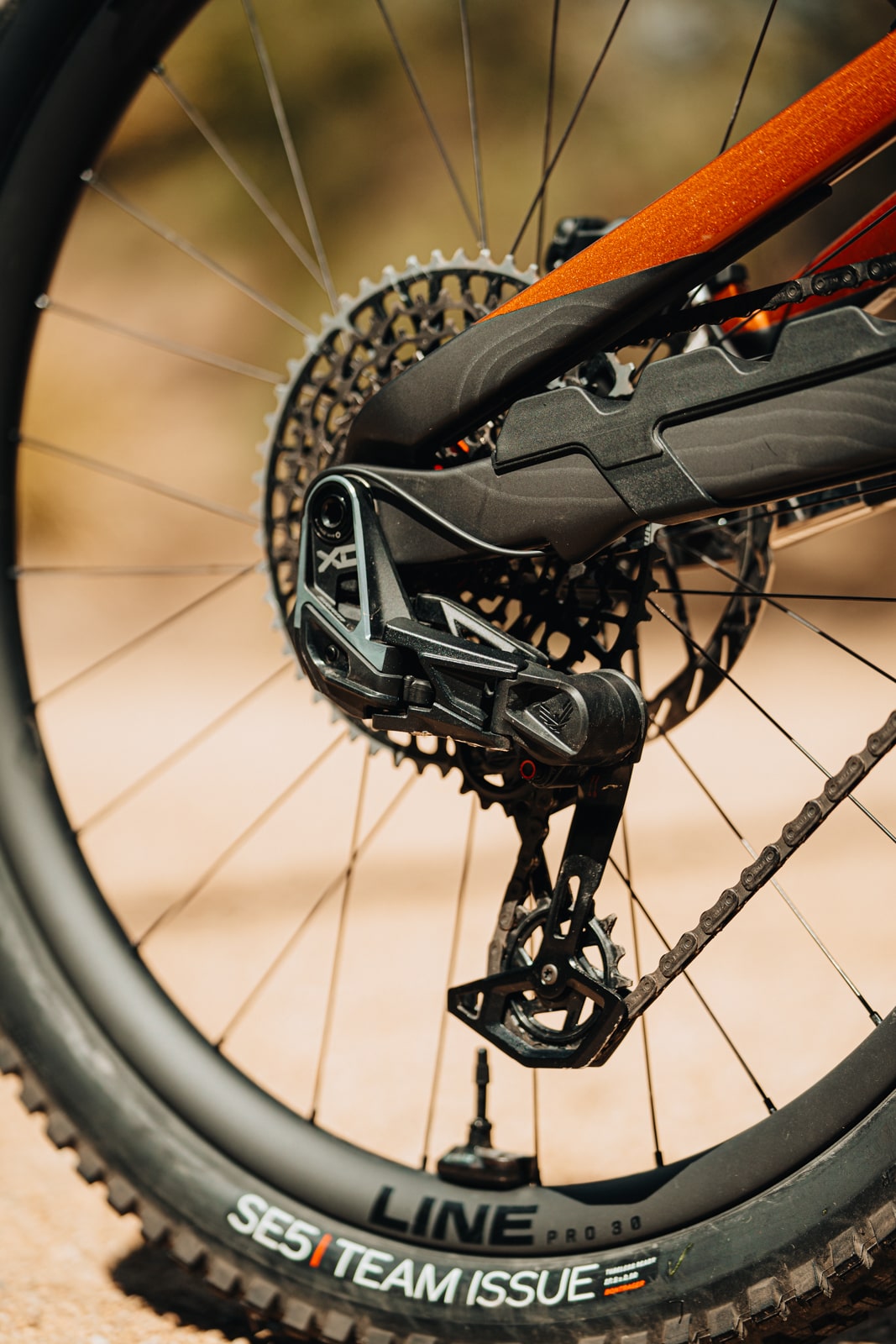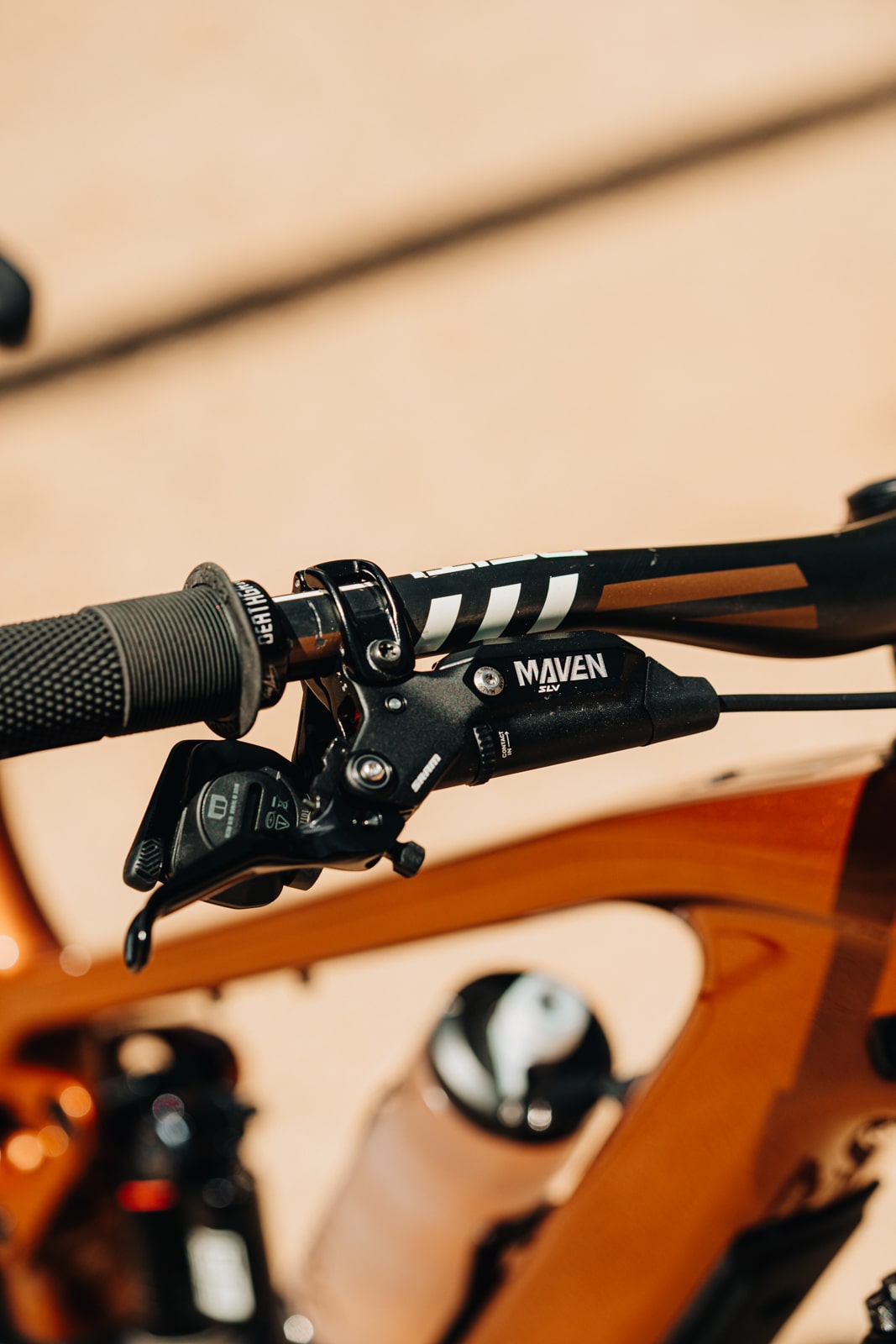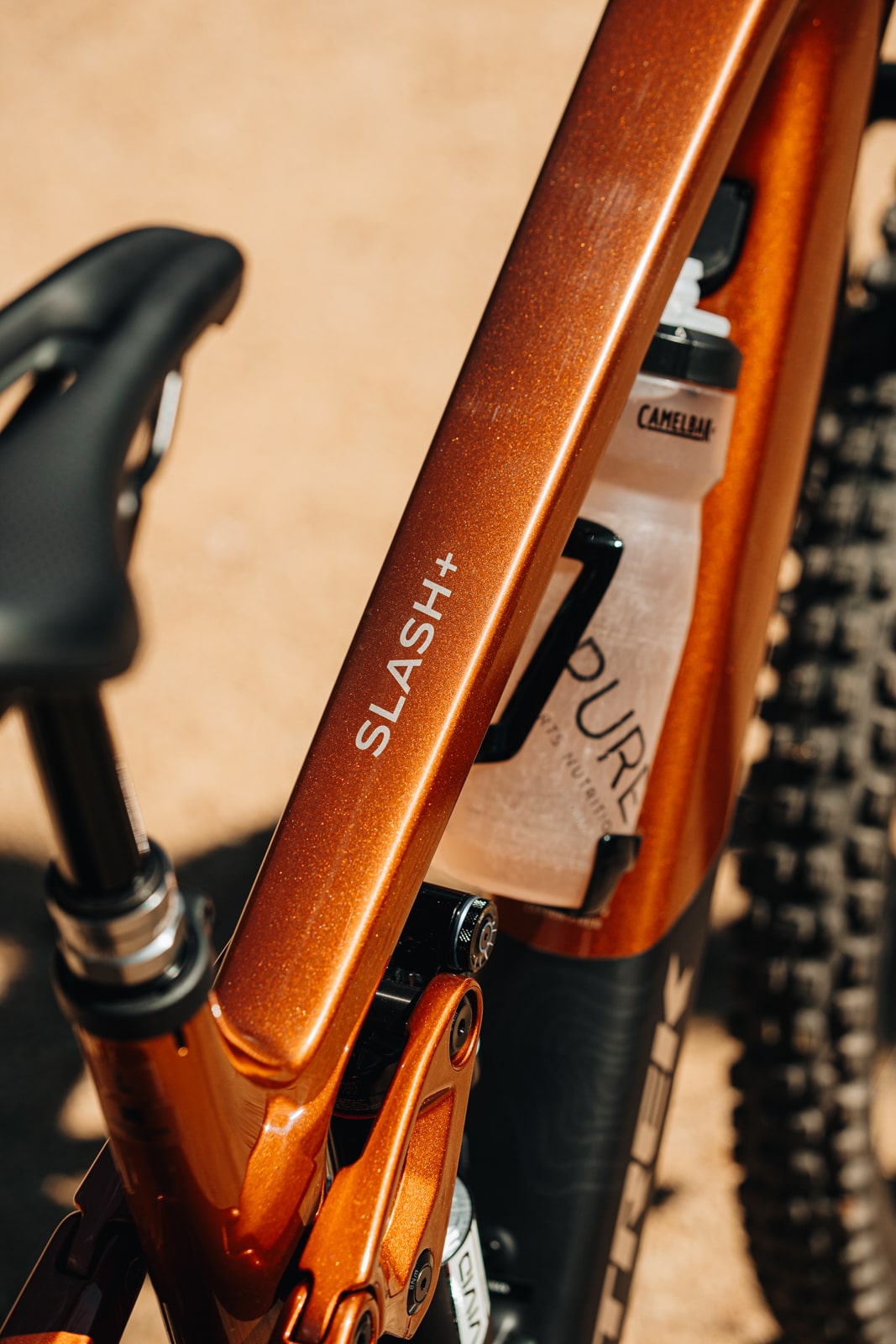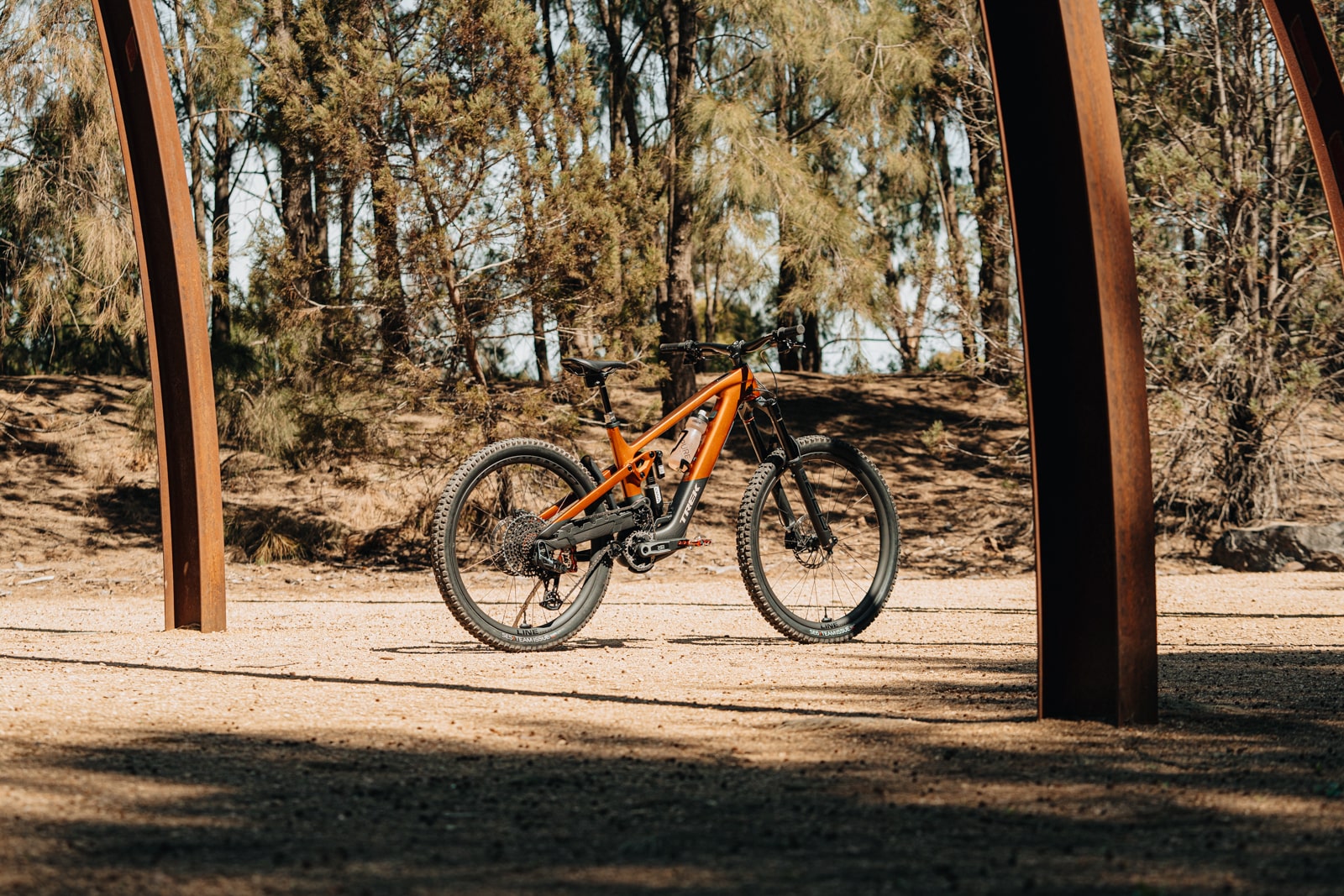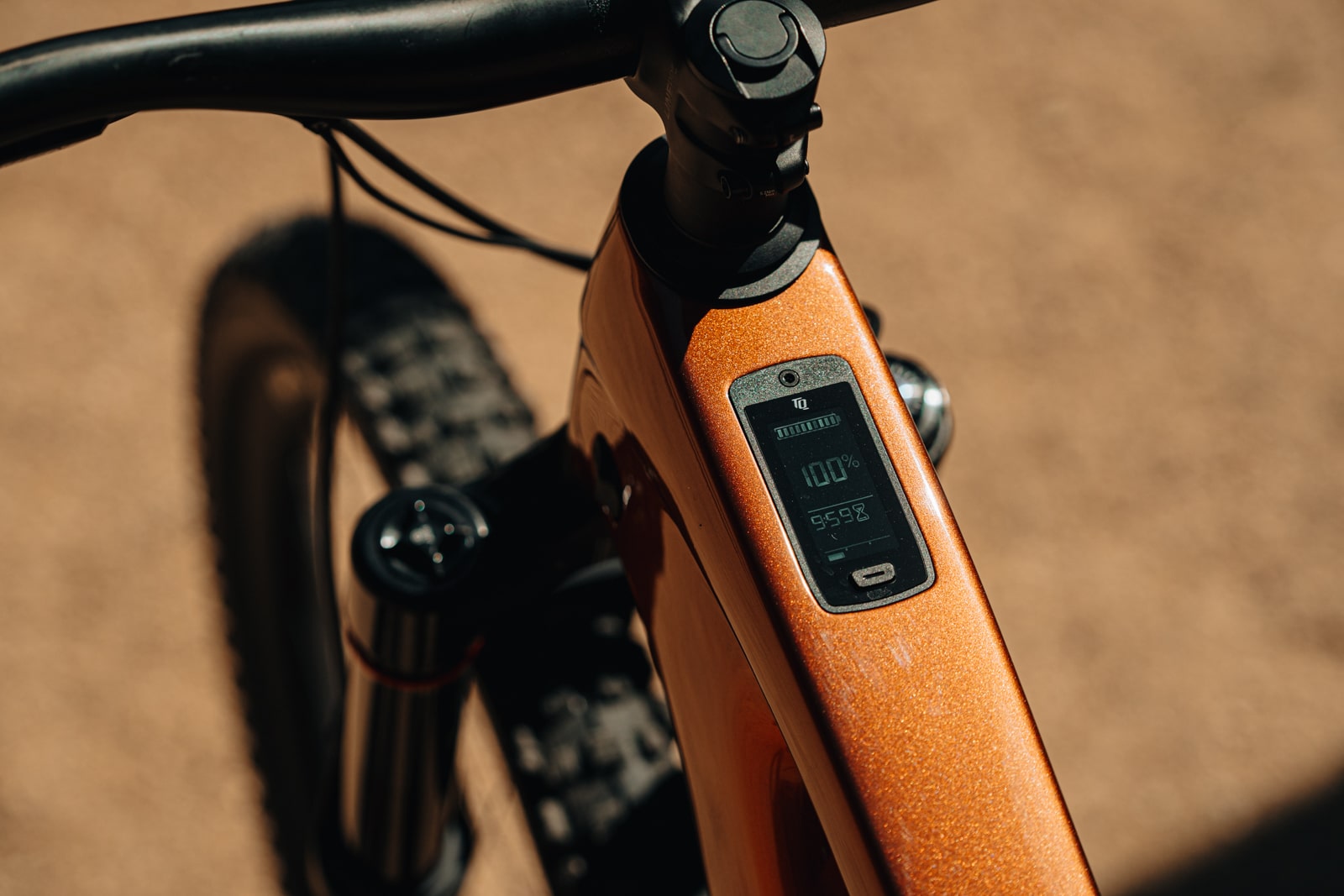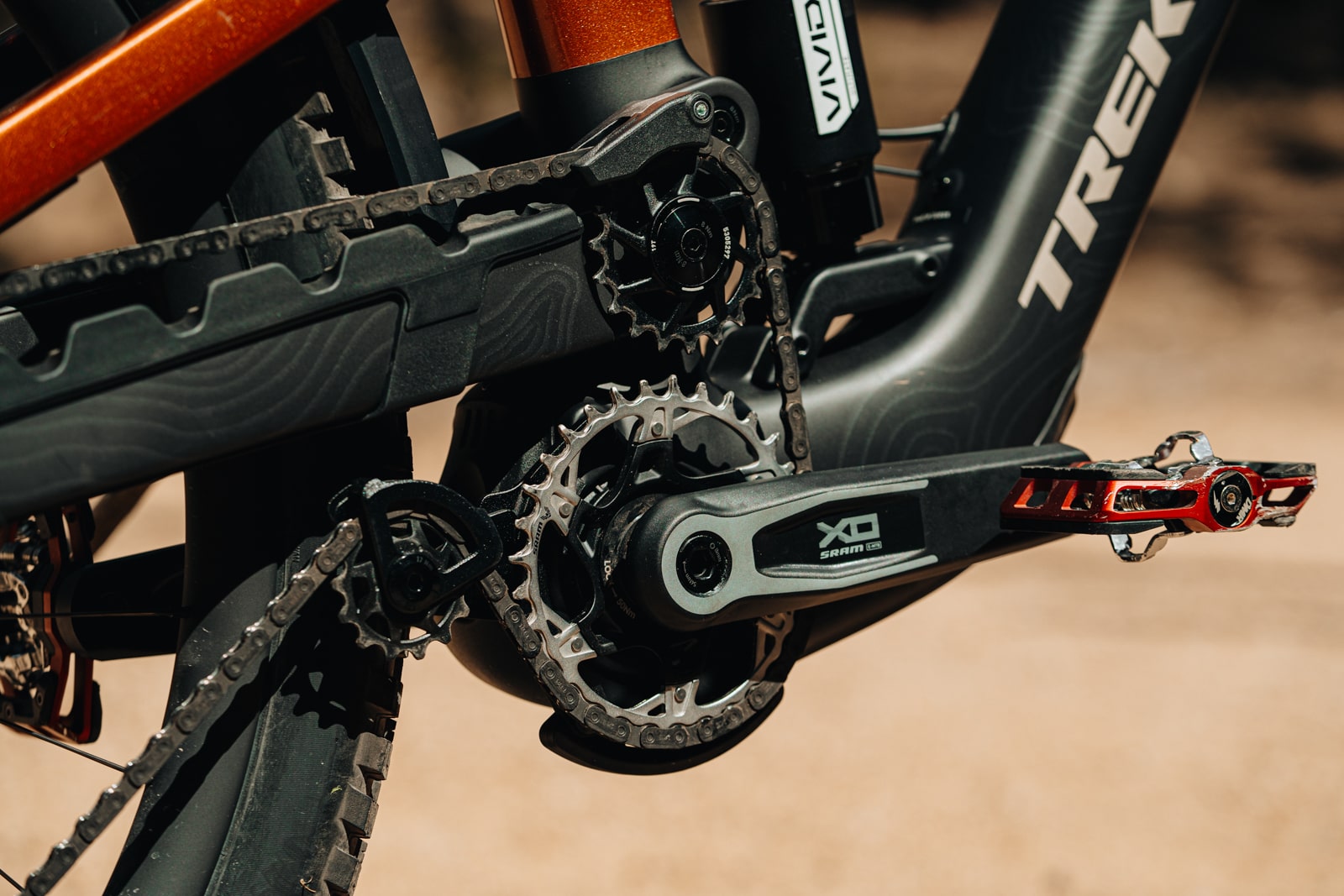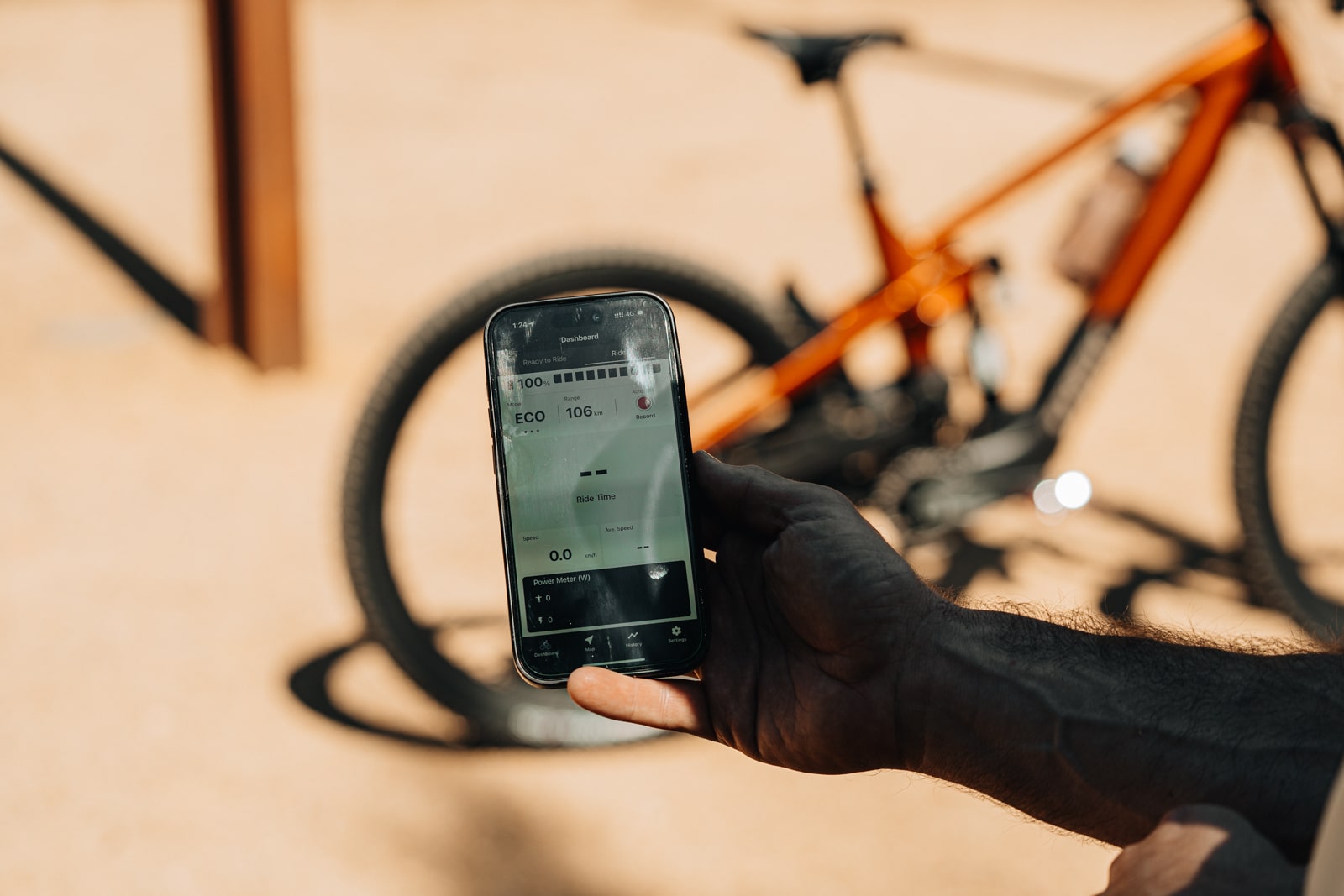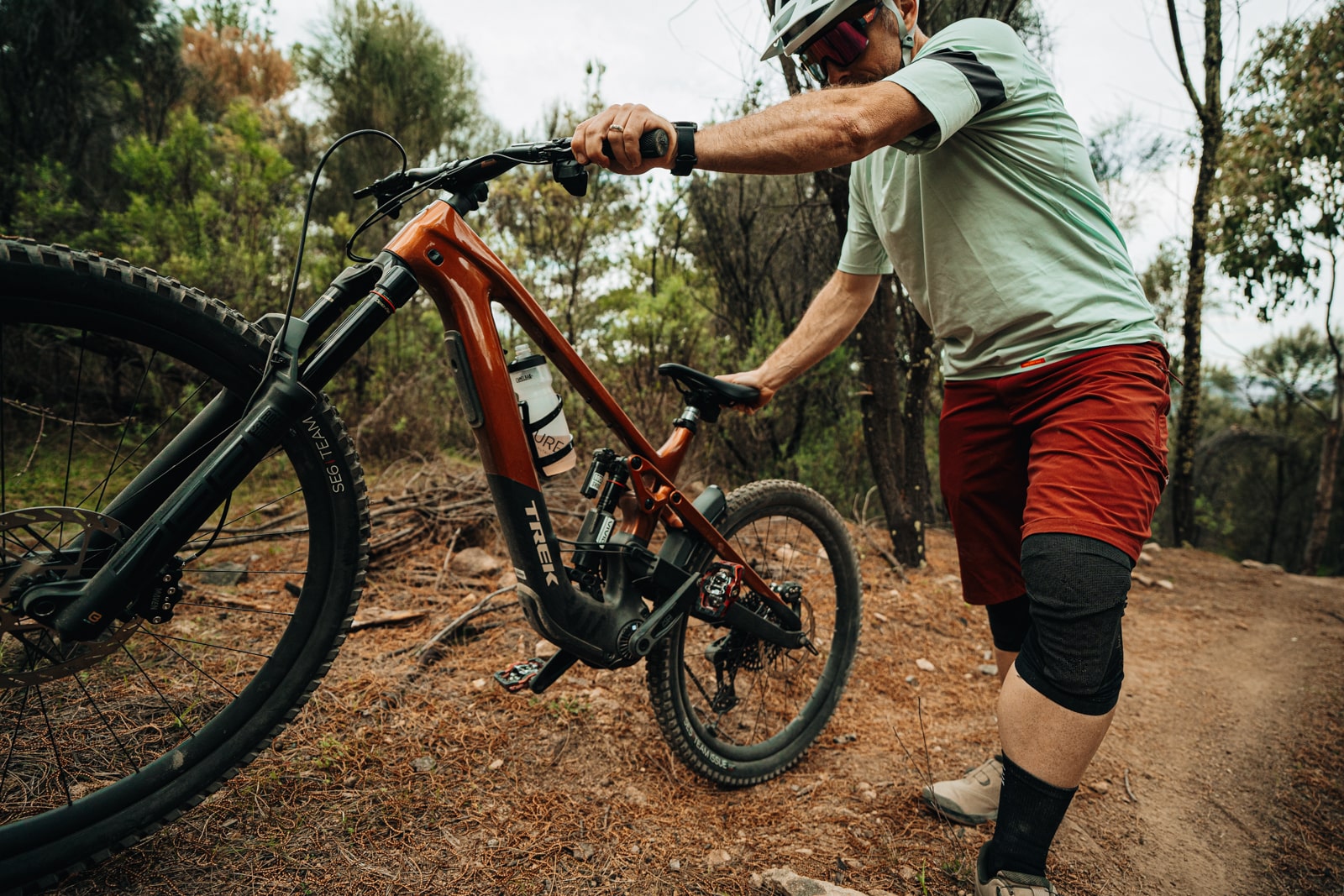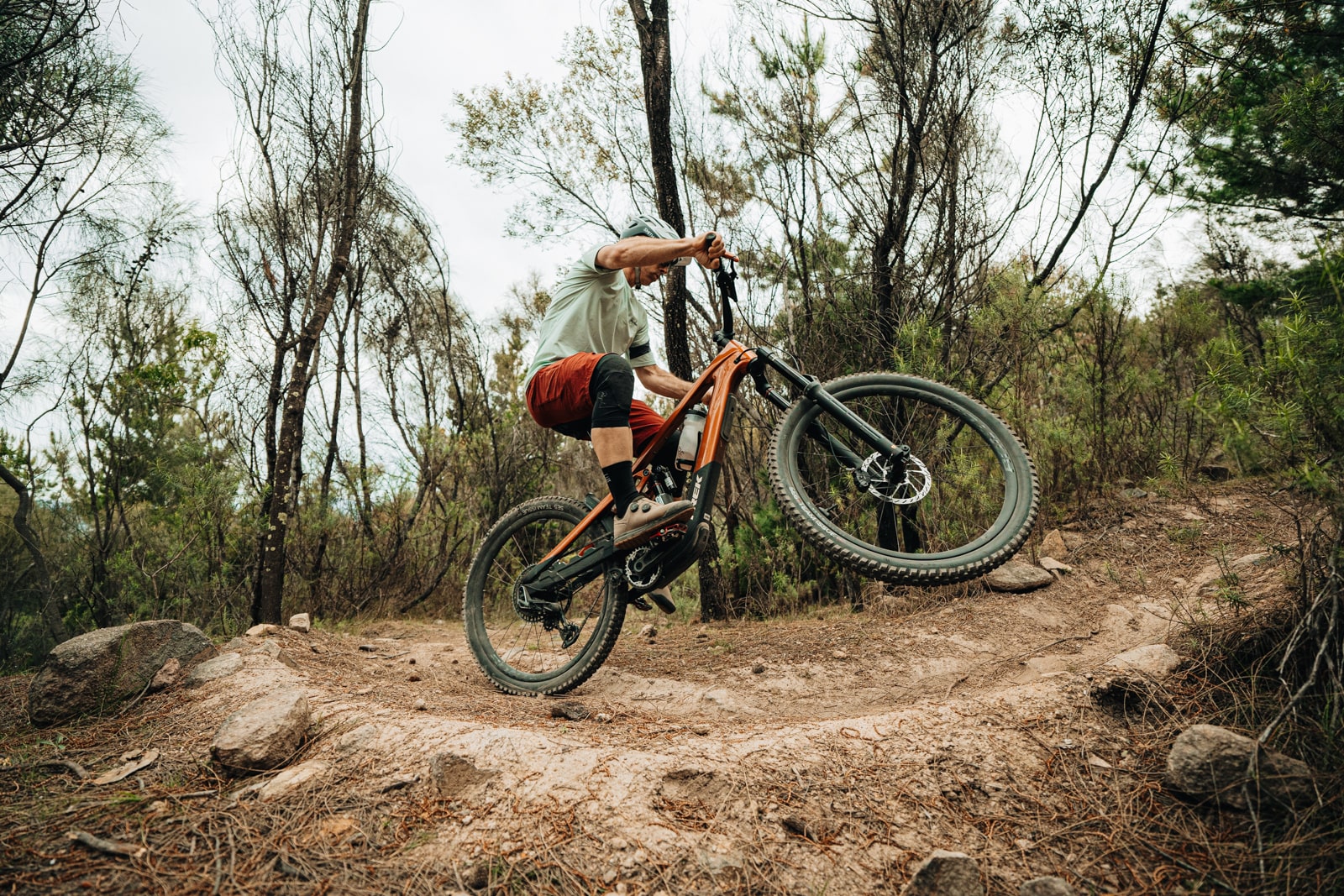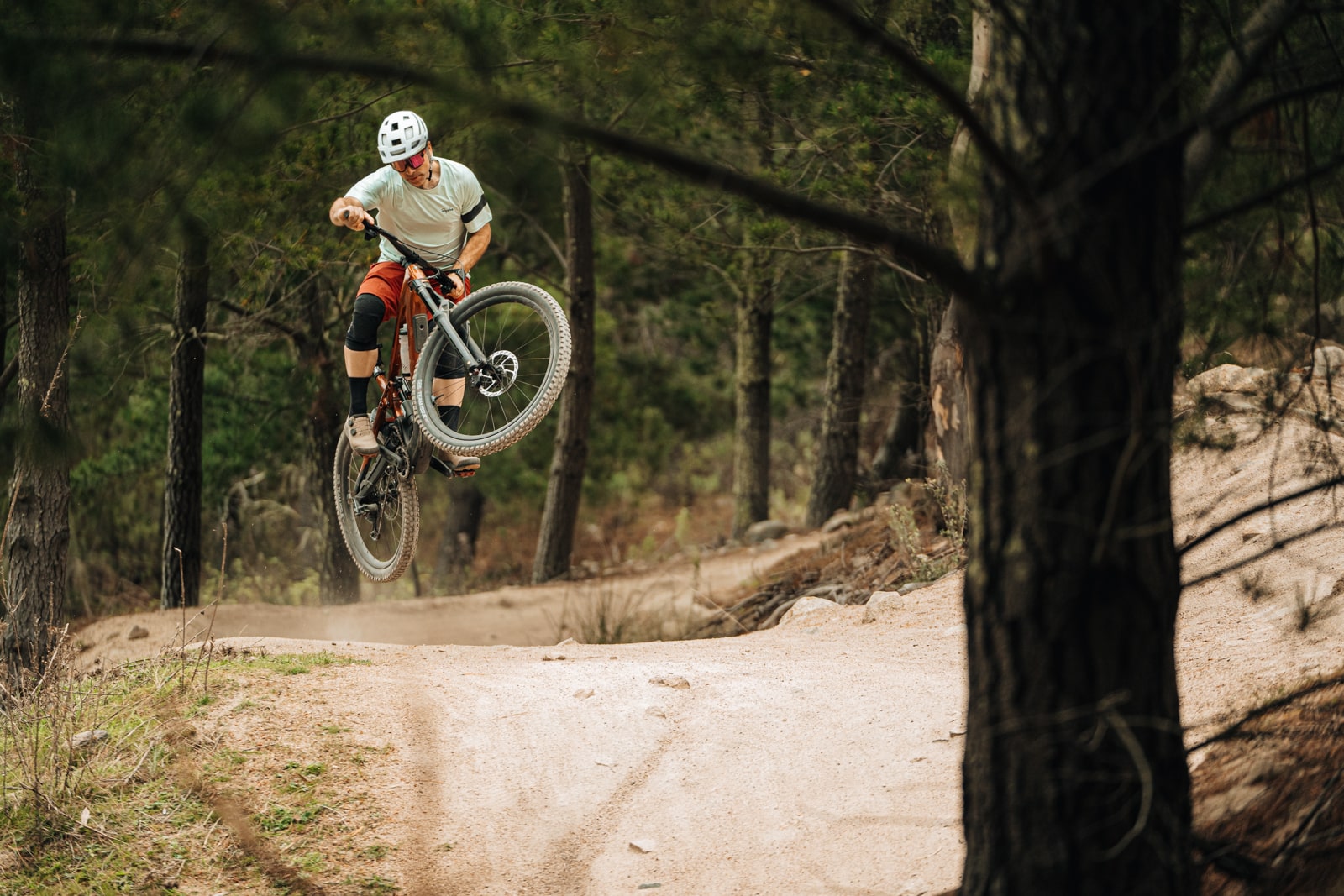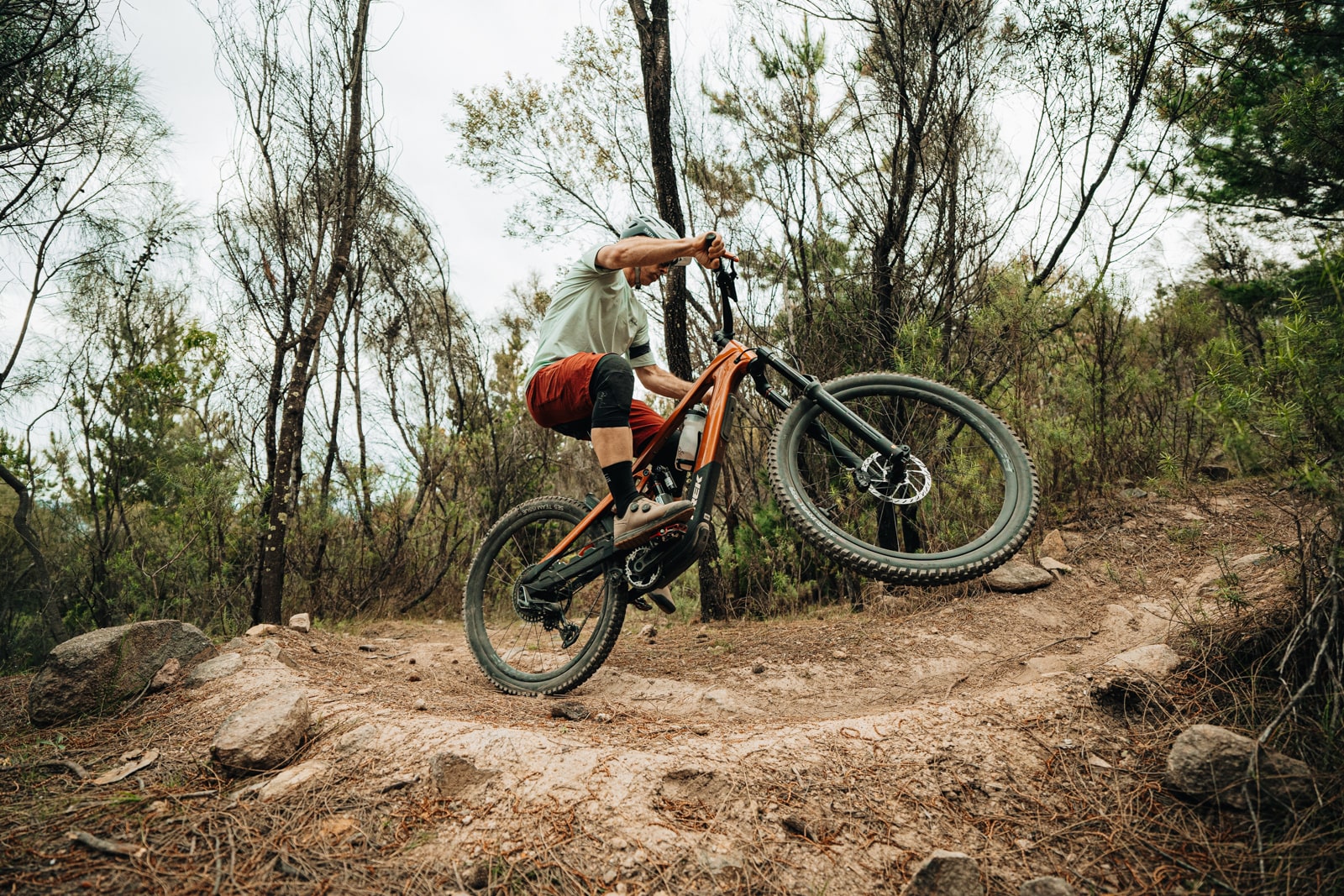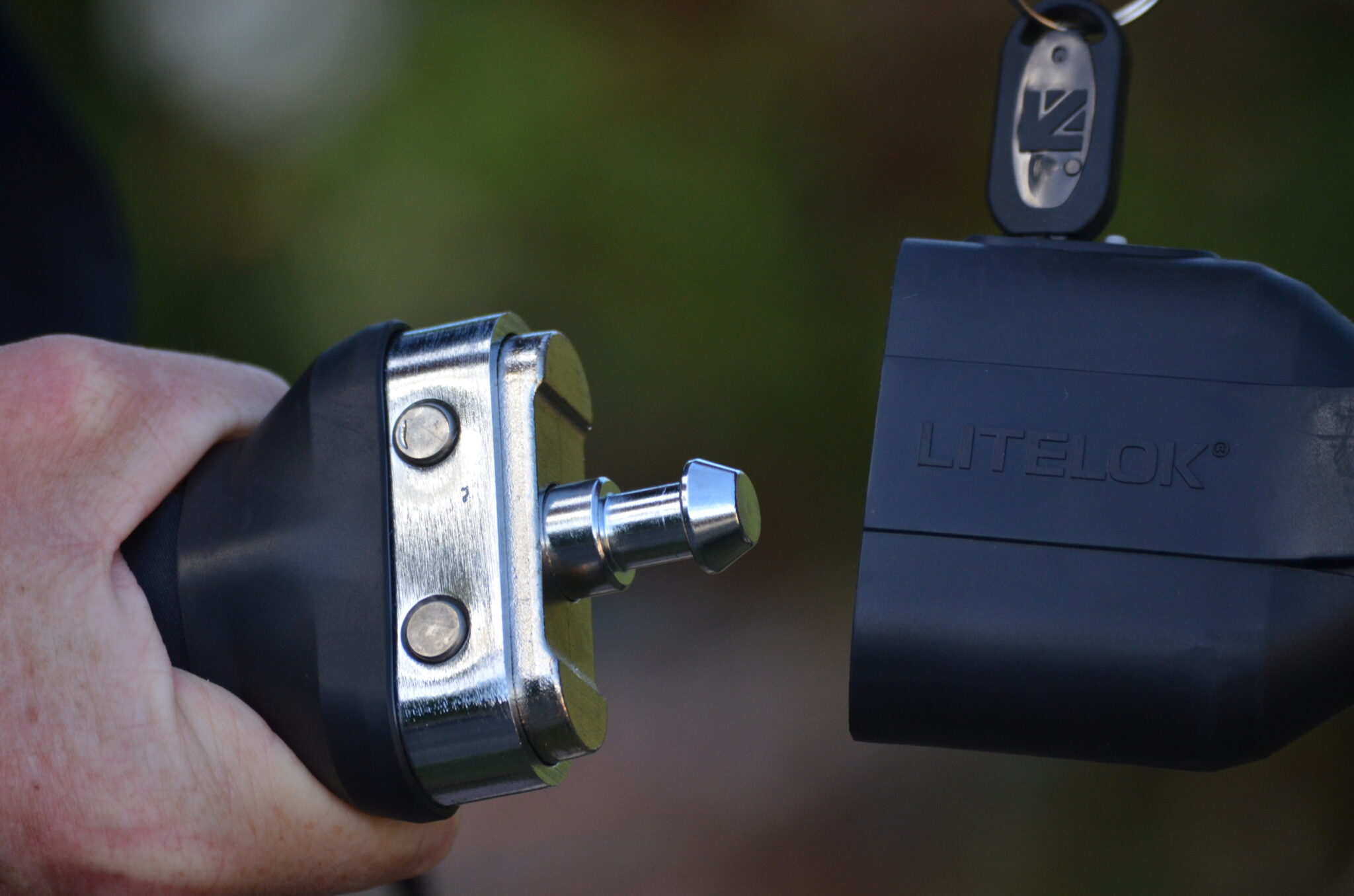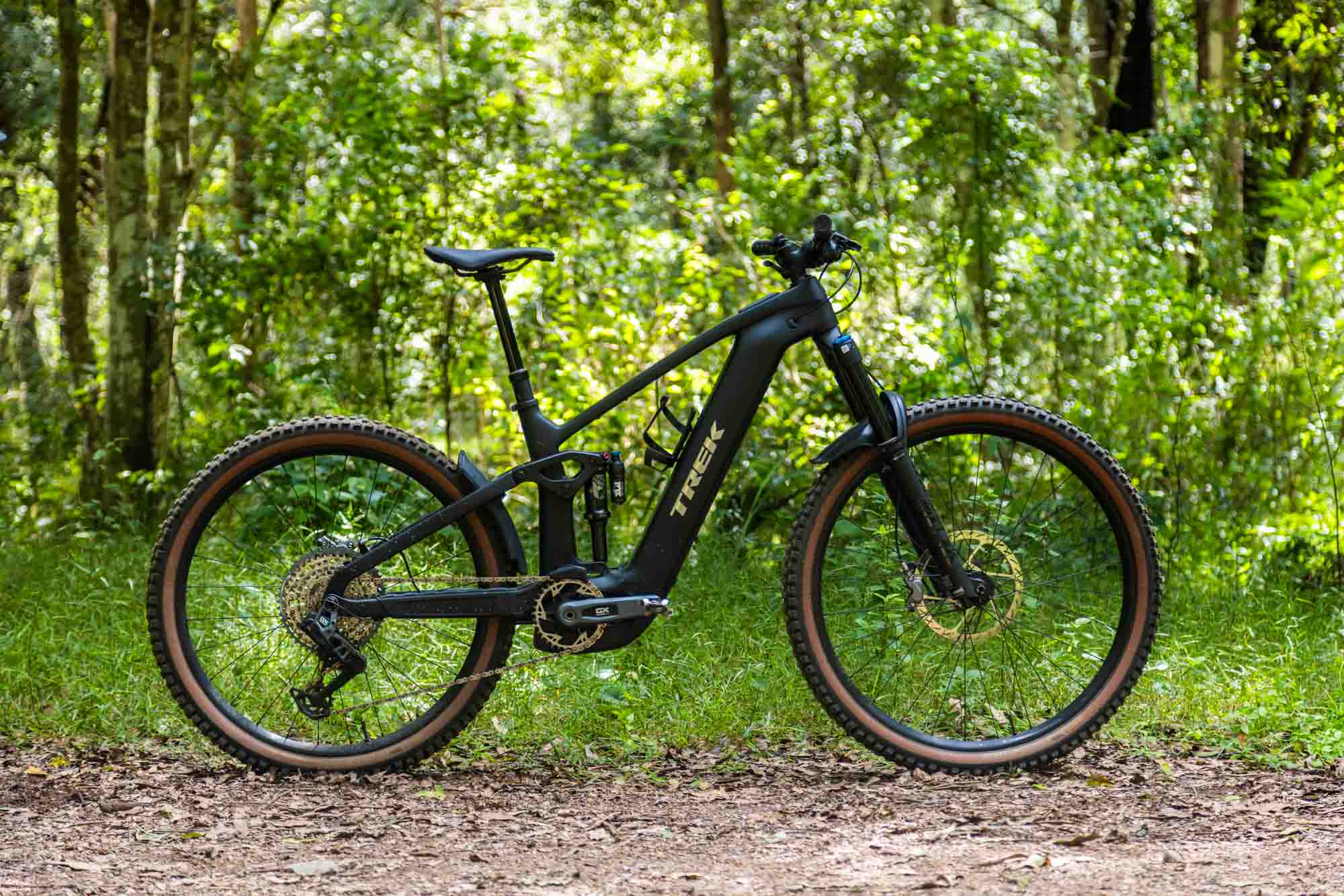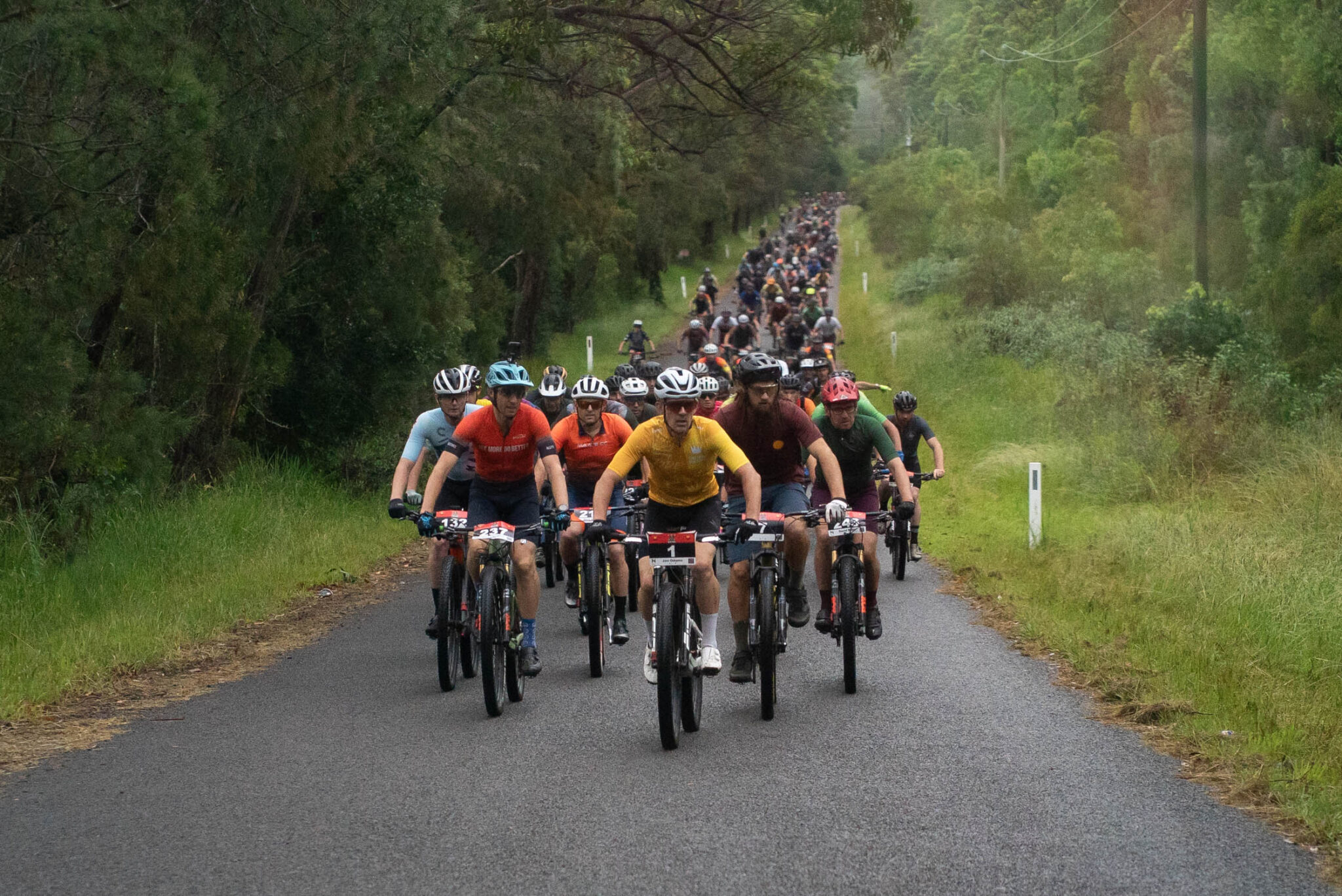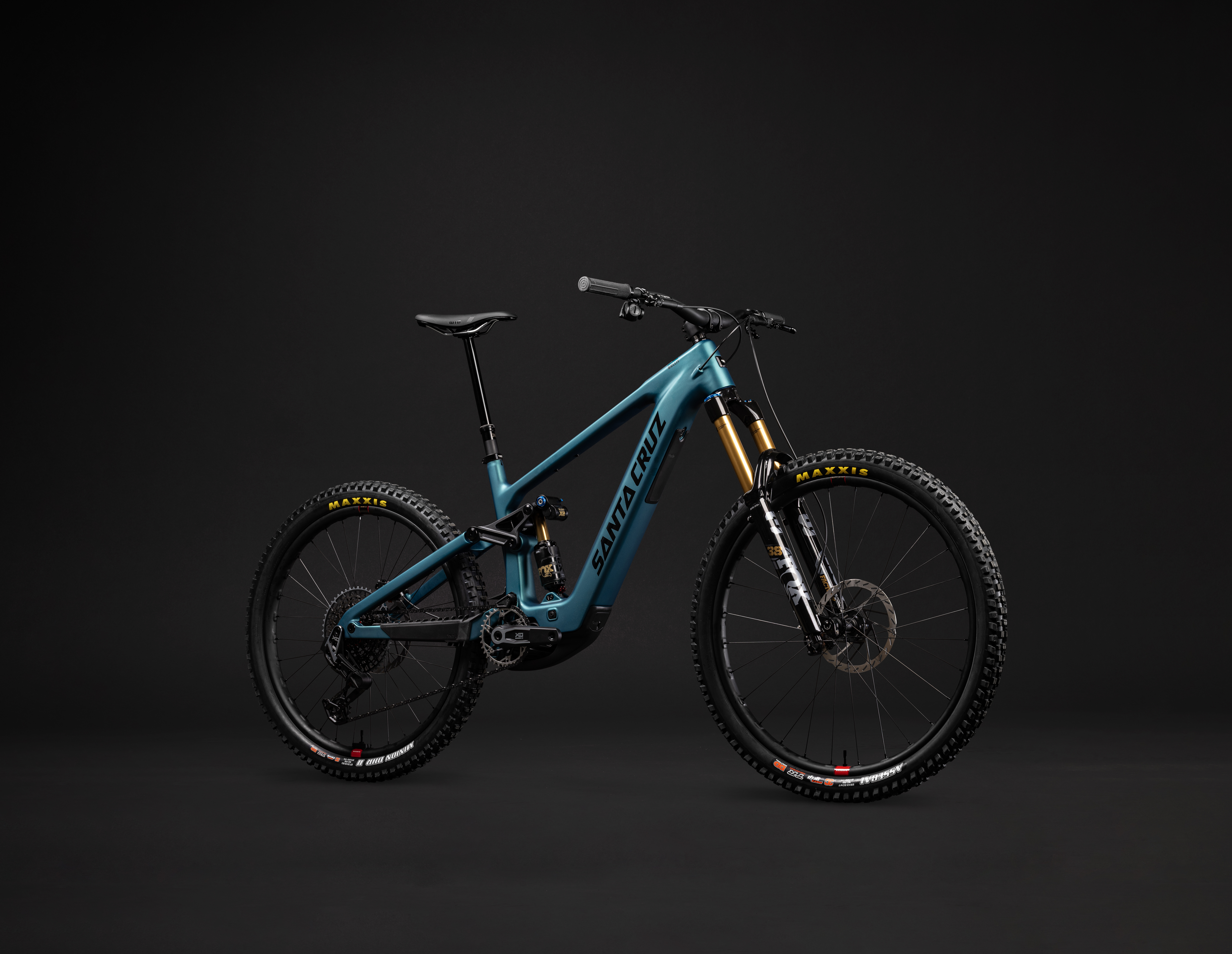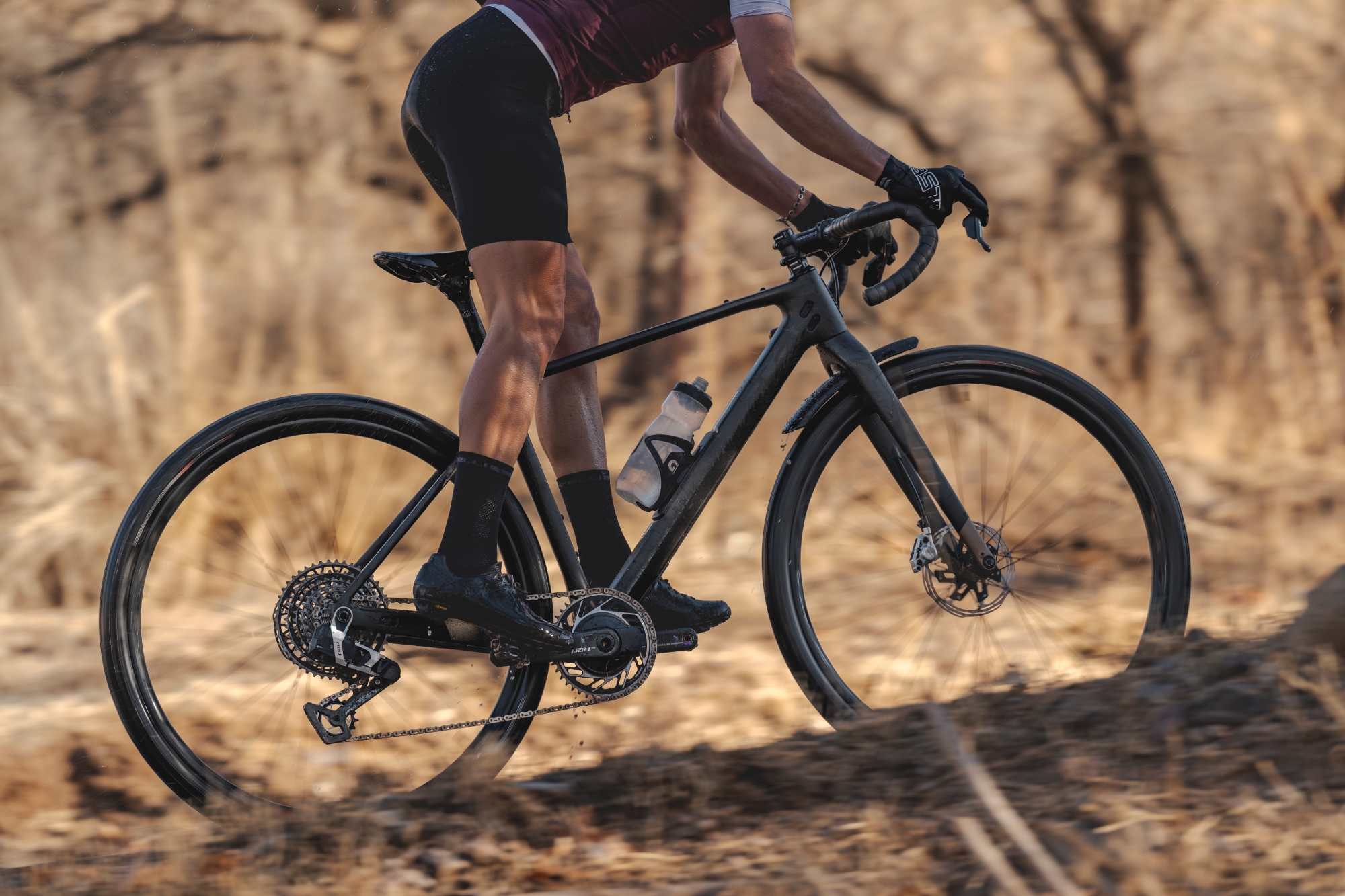Last year when I first rode the new Trek Slash platform, Trek was already at work on the e-version of the Slash, and as a result we have what I have riding here now being dubbed the Trek Slash+. The Trek Slash+ is an 170mm all-mountain, mid-power lightweight offering. It features a small drive unit and a mid-size battery in an effort to keep handling more like the analogue version of the Slash, yet with enough assistance from the motor to make a real difference to your ride.
The geometry, kinematics, and most of the frame details are all nearly identical to the Slash, save for a few details like a top tube screen and switch on the left side of the bars. In fact, at first glance the screen is quite incognito: most people did not notice that this was in fact a new bike I was on, let alone one with a motor. Trek is keeping this simple with just two levels of build to choose from, and a single paint option in each.
The Trek Slash+ lineup starts at $11,499.99 for the 9.7 and tops out at $17,999.00 for the 9.9 I have for test. While neither is cheap, they both offer well thought-out components and spec. To be honest, I actually expected the 9.9 I have been riding to be more expensive, given all the tech and electronics you get with it. This isn’t to say it’s perfect, which is what you’re aiming for at $1 off 18k: for me, in a replication of my experience with the analogue Slash the tyres left me a little wanting. I have been lucky of late that the trails have not been as dry as they can be as the Bontrager tyres are just far too hard for these conditions, and offer next to no grip. Luckily, this is a small consumable part, and not a deal breaker when purchasing a new bike.
So let’s take a deeper dive into the new Trek Slash+
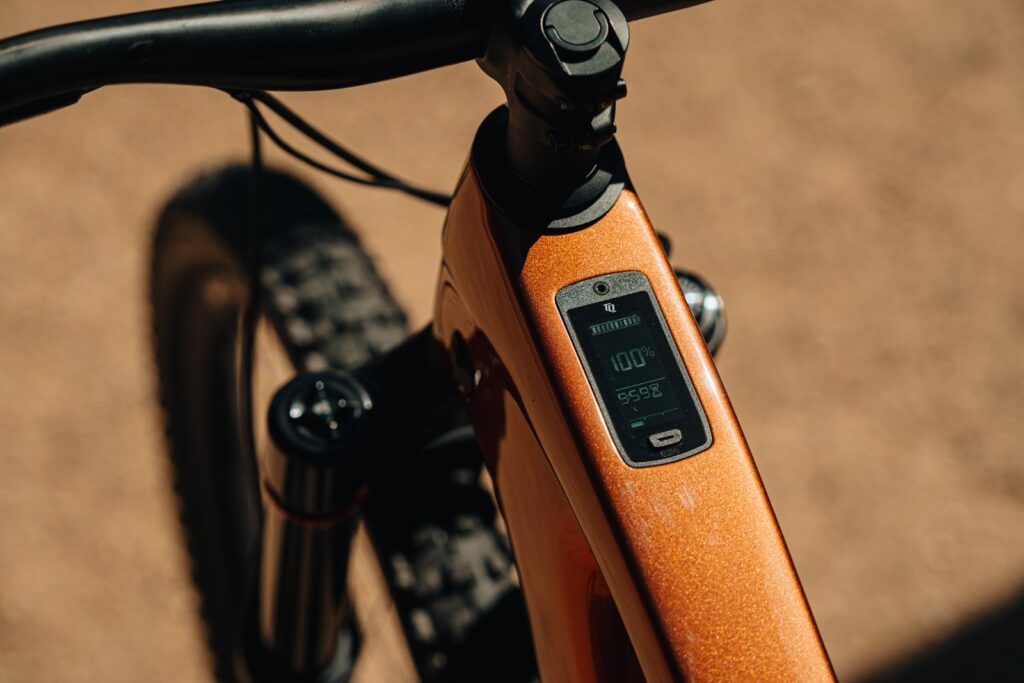
First Impressions on the 2025 Trek Slash+
As I said at first glance the Trek Slash+ is identical to the non-motorised Trek Slash, with a couple of key differences. The most obvious (other than a motor) being no in-frame storage, which as you may expect is something Trek were unable to do as it would impact the space occupied by the 580Wh battery. The charging port is at the top of the battery on the down tube, which is out of the way from the cranks and unlike some other bikes, this is covered by nice rubber gasket to keep the weather out along with dust and mud.
The new high-pivot design of the Slash carries through as you would expect, with a 19-tooth upper pully-wheel keeping things spinning fairly smoothly. The lower chain guide has been updated as well, with a direct mount to the motor taking out any potential misalignment in the system. Alignment of this was apparently the cause of the dropped chains on the analogue Slash, a simple fix for what was a bigger issue. Full disclosure I haven’t experienced a single dropped chain on the Trek Slash or Slash+.
The TQ-HPR50 motor used on both the Trek Fuel EX E and new Trek Slash+ has a very small silhouette that’s easy to miss to the untrained eye. In most trail situations, you can’t hear the motor at all, just the standard chain noises of a high pivot system, and tires on dirt. It features 50Nm torque, and the standard battery is the 580Wh.
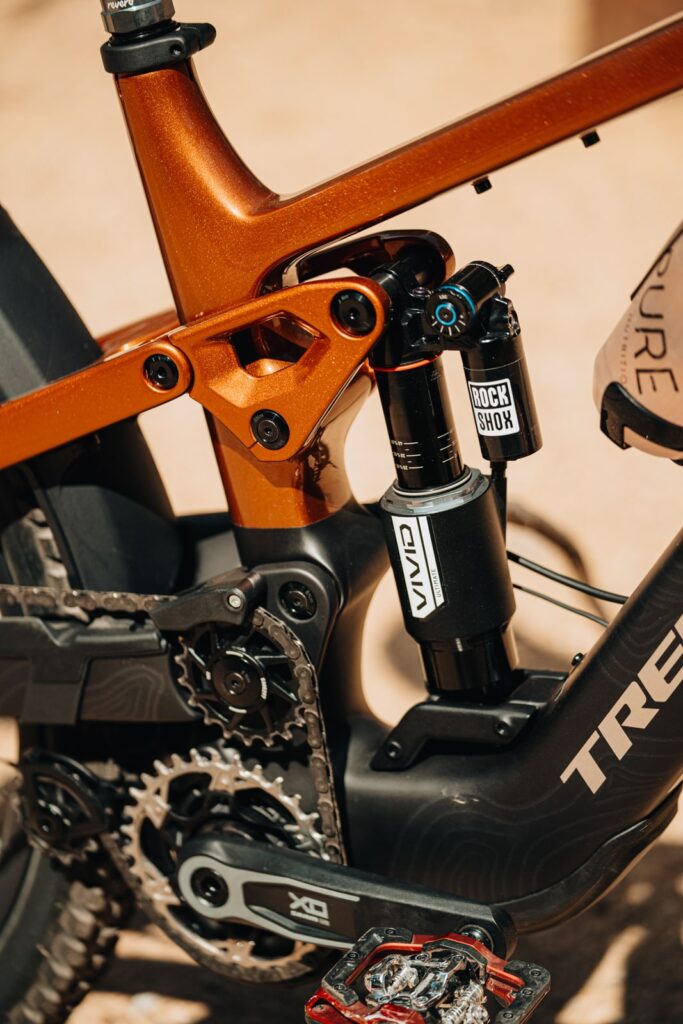
You can swap to the smaller 360Wh if you feel the need to lose some weight and don’t tend to use up all the juice of the 580Wh. To do this, all you need to do is remove two hex bolts fixing it in place, pop open the lower cover, and slide it out. There are two different end caps to accommodate the different sizes, so those are included in the swap. If you want extra juice, there’s a 160Wh bottle cage-mounted range extender available.
Trek made some pretty big claims about the stealth of the new Trek Slash+ with the term ‘tonality’ (how loud it is) aka the perception of sound the user feels with the TQ motor vs analogue, full power and light power-assisted bikes. E-bikes are becoming pretty remarkable that they now are getting so quiet, light and natural with their power delivery. Cost is perhaps the only reason not to recommend one to someone looking for a long-legged bike.
Geometry
Just like the Trek Slash I rode last year, the geometry of the Trek Slash+ is racy, its mullet setup cuts a nice balance between stablity at speed and agility in technical terrain. Reach numbers again are mostly the same kicking off with 430mm and going all the way up to 519mm, with bigger jumps at the bigger end of the range. This jump likely comes from the now missing M/L size which is what I had previously ridden and now forcing me onto a large. At first, I thought this was going to be an issue but honestly the reach was spot on, with the only issue being the lack of seat height adjust that I would have on an M/L.
The bottom bracket drop is low across the board and I never felt the need to run it lower, chainstay lengths are the same on the S, M, and L bikes (434mm), with the XL now being 5mm longer (439mm). The number sounds short and may make you question the 27.5” rear wheel (Trek have not spoken about use of a 29er rear wheel like in the analogue Slash) but due to the axle path, the chain stays actually grow up to 19mm and will have already started lengthening to around 11mm when at 30% sag.
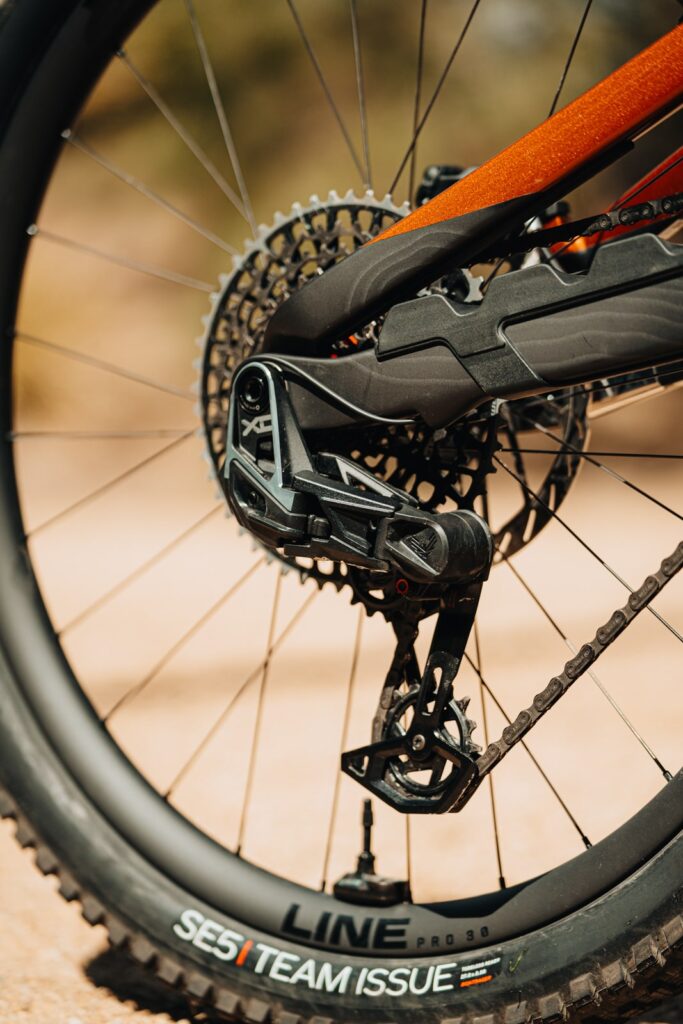
The head tube angle is adjustable ±1° using press-in headset cups available to purchase form Trek, and sits at 63.4° in the stock position. The seat tube angle sits around 77° in all sizes, with fairly steep for a Trek but not when you look at something like a Forbidden.
On the trail with the 2025 Trek Slash+
The Trek Slash+ is one of the only e-bikes I’ve ridden that’s true to their claim of near-silent motor operation. It is a small detail but it’s one of the first things you notice when you hop on an e-bike or ride with one.
For me, the bike performs incredibly well in fast, challenging terrain. Much like the Slash I liked so much, the suspension has a great balance of bump-eating and grip, making it feel confident in both high speed and janky sections of trail alike. After a short adjustment period, the growing rear-centre feels natural – if noticeable at all – and the bike cruises though jumps and pops off rock ledges with ease. The platform offers a supportive ride on flow trails as well, and hides a bit of its long travel legs. This should come as no surprise as both the Slash (that’s now the Enduro Race bike for Trek) and Slash+ use the same basic geometry and suspension platforms.
Because of this, it makes me wonder why Trek are updating their Rail with a full powered motor like the Bosch Performance Line CX Race or SRAM Powertrain when they have already proven they can make The Slash+ ride like the Slash. Would an extra few kilo’s really impact the design and ride so much they need another bike? While you do notice a little less power than a full-power e-bike on the climbs, it’s not so significant that mates on a normal bike don’t want you around, and likewise you can keep up with the big drive-unit e-bikes if you’re committed to putting in more effort than usual: its really not that big of an issue.
The only issue we experienced is that there is a creak under pedalling that I have not been able to find. I have done everything but remove the motor and battery, applying new grease, cleaning and checking the pivot’s torque settings, the cranks and seat post, hoping I won’t have to pull out the motor. The noise is totally gone descending but is something that does turn heads when pedalling past someone on an open fire road.
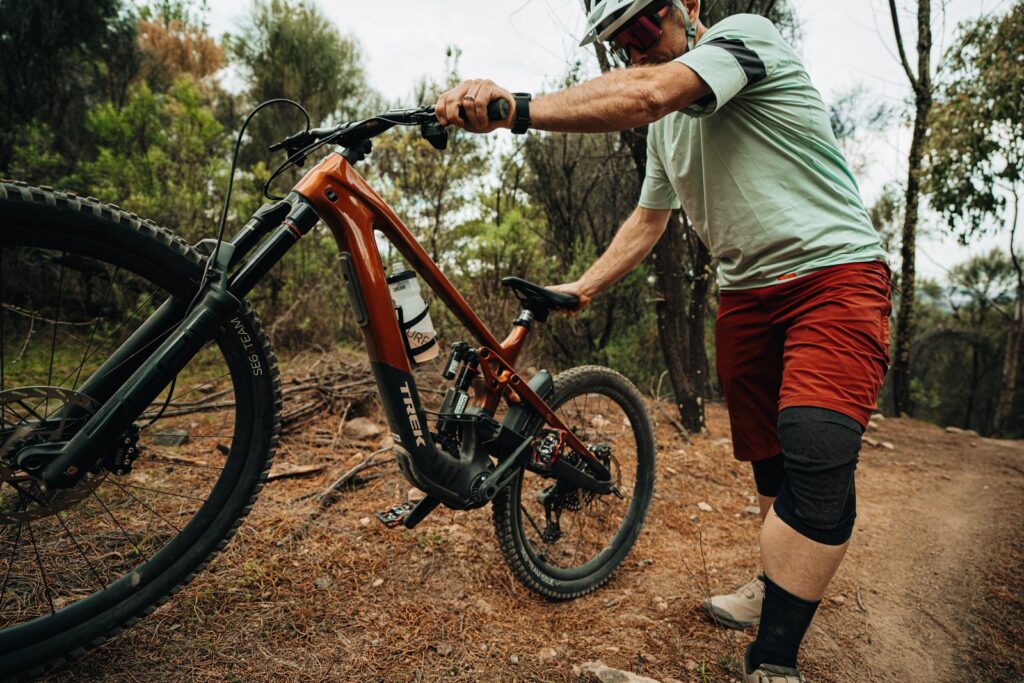
Final Thoughts on the Trek Slash+
My time on the Trek Slash+ has been great, its one of the best – if not the best – e-bikes I have ridden…but I say this with a caveat. I do love this bike but due to its smaller motor and less torque I would not choose it as a E-Enduro race bike. E-Enduro is still young in Australia and if you are fit, I think it will be fine, but if you are going head to head with your doppelganger on something like a GASGAS MXC 5 then your work is going to be cut out for you.
Trek’s New Slash+ is a bike that’s for fun and oozes pure speed when pointed at a trail! If you watch the marketing video Trek put out, they too think this is a bike made to increase the amount of fun you can have with a bit less effort.
Chapeau Trek to the extra good times.
Trek Slash+ 9.9 Specs
Brand: Trek
Model: Slash+ 9.9
RRP: $17,999.00
Weight: 21.1 kg (as tested, tubeless, without pedals)
From: Trek Bikes
Available Sizes: S, M, L, XL
Frame Material: Carbon Fiber
Fork: RockShox ZEB Ultimate, 170 mm
Shock: RockShox Vivid Ultimate, 170 mm
Shifters: SRAM AXS Pod Ultimate Controller
Derailleur: SRAM X0 Eagle AXS, T-Type
Crank: SRAM X0 Eagle, 160 mm length
Bottom Bracket: TQ-HPR50
Chain: SRAM X0 Eagle, T-Type, 12-speed
Cassette: SRAM Eagle XS-1295, T-Type, 10-52, 12-speed
E-Bike Drive Unit: TQ-HPR50, 50 Nm, 250 watt
E-Bike Battery: TQ 580Wh
Hubs: Bontrager
Spokes: Alloy
Rims: Bontrager Line Pro 30, OCLV Mountain Carbon
Tyres: Bontrager SE5 Bontrager Line Pro 30, OCLV
Mountain: Carbon 27.5” rear; Bontrager SE6 Team Issue 29” front
Brakes: SRAM Maven Silver
Stem: Bontrager Line Pro 35
Handlebars: Bontrager Line Pro, OCLV Carbon, 35 mm, 27.5 mm rise, 780 mm width
Seatpost: RockShox Reverb AXS, 170 mm, Dropper post
Saddle: Bontrager Verse Comp
NEED TO KNOW
Riding Experience::
Far too long racing, riding and developing products for all kinds of bikes.
Generally Rides:
Pivot Firebird, Cervelo Aspero, Giant Propel
Height: 177cm
Weight: 78kg
Bike Test Track: ANU Bike Park, Stromlo Forest Park, Poo Pines, Majura Pines
